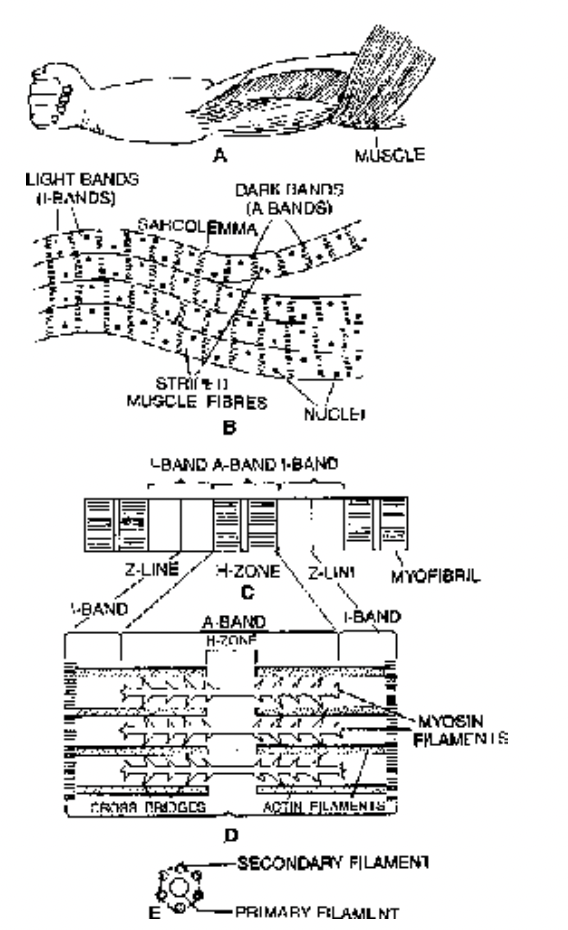Muscular Tissue
Animal Tissues of Class 11
Mesodermal in origin.
The terms like Myo and Sarco are used in context with muscles.
Myoblasts - give rise to muscle fibres.
Myocytes (sarcocytes) - are muscle cells.
Myofibrils - fine fibrils present in the muscle fibre, these are made up of myofilaments.
Sarcoplasm - Cytoplasm present in muscle cells.
Sarcolemma - Plasma membrane of muscle fibres.
Contractility and electrical excitability are the most specialized properties of muscular tissue.
Functions of Muscular tissue
Responsible for the movement of the body parts and locomotion of the individual.
Muscles bring about peristalsis in intestine, heart beat, production of sound etc.
Facial expression depends on muscles.
Supports the bones and other structures.
Makes up about 40% of the body weight in mammals, classified into three types:
(a) Skeletal
(b) Visceral
(c) Cardiac
Skeletal muscle is attached to bones (except tongue muscles and muscles of upper part of oesophagus). It is also known as striated, somatic, phasic or voluntary muscle.
Visceral muscle is located in viscera. It is also known as non-striated, smooth, or involuntary muscle.
Cardiac muscle is found in wall of the heart. It is striated and involuntary.
Striated Muscles
- Muscle fibre has stripped appearance when viewed under microscope.
- Muscle fibres are formed by myoblast. The nucleus undergoes repeated divisions.
- A stripped muscle fibre is multinucleated and it is a syncytium (coenocyte).
- Fine fibrous connective tissue surrounding individual muscle fibre is called endomycium.
- The parallel bundles of muscle fibres are called fasciculi, surrounded by perimycium.
- The entire muscle is usually wrapped with a fibrous connective tissue called epimycium.
- The smooth endoplasmic reticulum of a muscle cell is called sarcoplasmic reticulum. It stores Ca2+.
- Major component of striated muscle is water (75%).
- The proteins present in muscles are actin, myosin, troponin, myoalbumin, myoglobulin and myogen.

Fig. Structure of striated muscle at different levels of magnification
- The non-protein components of muscle are ATP, phosphocreatine, creatine and urea.
- Potassium is abundantly present in muscles. The minerals present in traces are sodium, calcium, phosphorus and magnesium.
- Muscles are the site of storage of glycogen.
- An iron-containing pigment called myoglobin or muscle haemoglobin transports oxygen in muscles.
Structure of striated muscle
- Skeletal muscle fibre possess transverse striations in the form of regular alternate dark A (anisotropic) and light I (isotropic) bands.
- Tissue
- Types of Animal Tissues
- Epithelial Tissue
- Covering and Lining Epithelium
- Glandular Epithelium
- Connective Tissue
- Skeletal Tissues
- Vascular Tissues
- Origin of Blood Cells
- Erythrocytes/RBC's
- Leucocytes/WBC's
- Blood Clotting
- Lymph
- Muscular Tissue
- Nervous Tissue
- Integument
- Exercise 1
- Exercise 2
- Exercise 3
- Exercise 4
- Exercise 5
- Exercise 6









